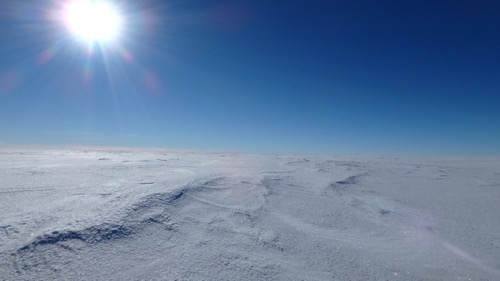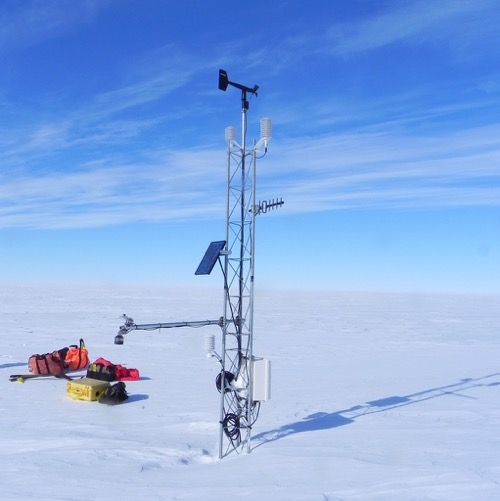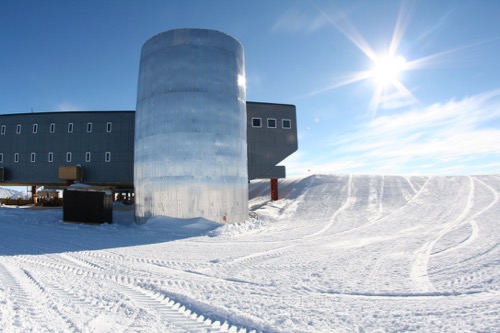The things I am most looking forward to while I am in Antarctica… aren’t there. Let me explain.
Smells
Once I get away from the coast and open water, there will be no smells. Organic, both living and decomposing things produce most of the odors we normally smell. On the continent of Antarctica, away from open water, there is nothing but ice, for hundreds of miles in any direction. Ice doesn’t have an odor. I’ve never experienced a place that doesn’t have any odors at all. Even when we think we don’t smell anything, we actually do. Our brains just filter out all of the normal and therefore, unimportant odors. Only something out of the ordinary will register with our conscious mind. Being on the ice should be just the opposite. Since there will be nothing to smell, I should be immediately aware of the most ordinary and mundane odors because there will be nothing else to smell.
 No smells or sounds on an ice sheet. Photo by Kate Miller (PolarTREC 2016), Courtesy of ARCUS
No smells or sounds on an ice sheet. Photo by Kate Miller (PolarTREC 2016), Courtesy of ARCUS
Sounds
There is a whole lot of nothing in Antarctica. It is a very
quiet place. At times, my team and I may be hundreds of miles from the
next living thing. We will be out on vast, featureless ice sheets with
nothing but the wind to make any noise at all. Even the wind will
not sound like it does back home. At home, there are trees and
buildings, corn stalks and grass that the wind blows through. A lawnmower, a car
or an airplane in the distance can always be heard. As a school teacher, my world at school
is anything but quiet. But out at the remote locations of the Automatic Weather Stations, there will
be… nothing. I’ve recently read that in the Antarctic silence you can hear the
glacier below you grind and groan as it slowly slides off the continent
on its 100,000-year journey to the sea. I’ve also read that the ice can
make a gentle and almost imperceptible hum under certain conditions.
Does silence have a sound?
Children
I am a school teacher and a father and Boy Scout leader. I’ve been surrounded by children, either my own or my students for decades. I’m doing this expedition for children. The entire purpose is to become a better and more engaging teacher to inspire children to become lifelong learners and consider science as a career. But while I am doing this FOR children, there will not be a single child on the continent.
 Not a child in site. An Automatic Weather Station (AWS) near McMurdo Station, Antarctica. Photo by George Hademenos (PolarTREC 2017), Courtesy of ARCUS
Not a child in site. An Automatic Weather Station (AWS) near McMurdo Station, Antarctica. Photo by George Hademenos (PolarTREC 2017), Courtesy of ARCUS
Darkness
 he South Pole Station at 2:48AM. As the earth rotates, the sun stays at the same elevation above the horizon. The highest it will get will be 23.5 degrees above the horizon on the summer solstice, December 21st. In March, the sun slowly sets for the entire winter, and it doesn't rise again until September. At the Amundsen-Scott South Pole Station, Antarctica. Photo by Casey O'Hara (PolarTREC 2009/2010), Courtesy of ARCUS
he South Pole Station at 2:48AM. As the earth rotates, the sun stays at the same elevation above the horizon. The highest it will get will be 23.5 degrees above the horizon on the summer solstice, December 21st. In March, the sun slowly sets for the entire winter, and it doesn't rise again until September. At the Amundsen-Scott South Pole Station, Antarctica. Photo by Casey O'Hara (PolarTREC 2009/2010), Courtesy of ARCUS
There will be 24 hours of daylight for the entire time I’m there. I am actually fortunate enough to be at the South Pole very near the solstice (December 22 at 11:22 AM) At that time on that day, at the Geographic South Pole, the sun will appear to revolve 360˚ around the earth at 23.5˚ above the horizon. (It is, of course, the Earth that is rotating as it revolves around the sun.) It will be just as bright sunshine at 3:00 AM as it is at 3:00 PM. The sun will just be 180˚ in the opposite direction. I will be packing a sleeping mask to help me to sleep in broad daylight, but even then I anticipate having trouble sleeping.
So to summarize, the things I’m most looking forward to while being in Antarctica… will not be there!


Comments
Add new comment